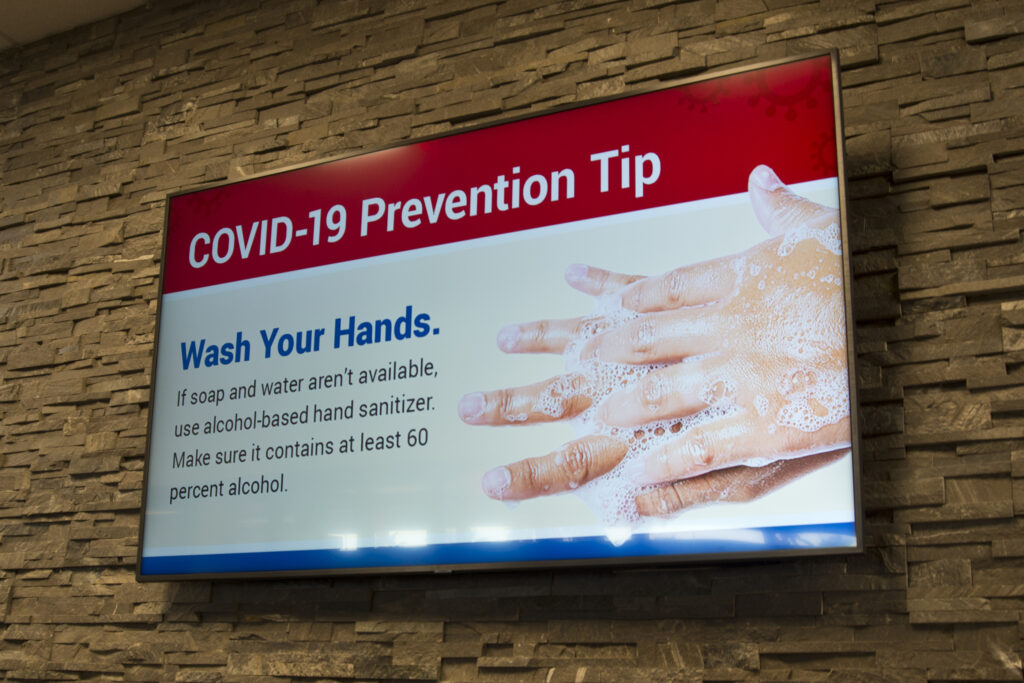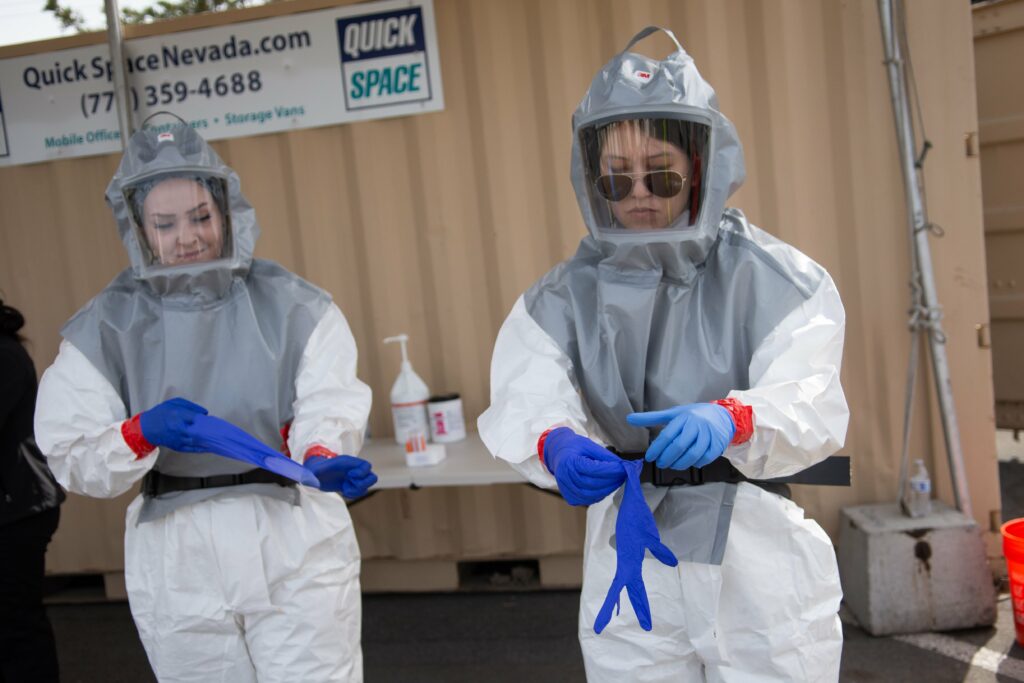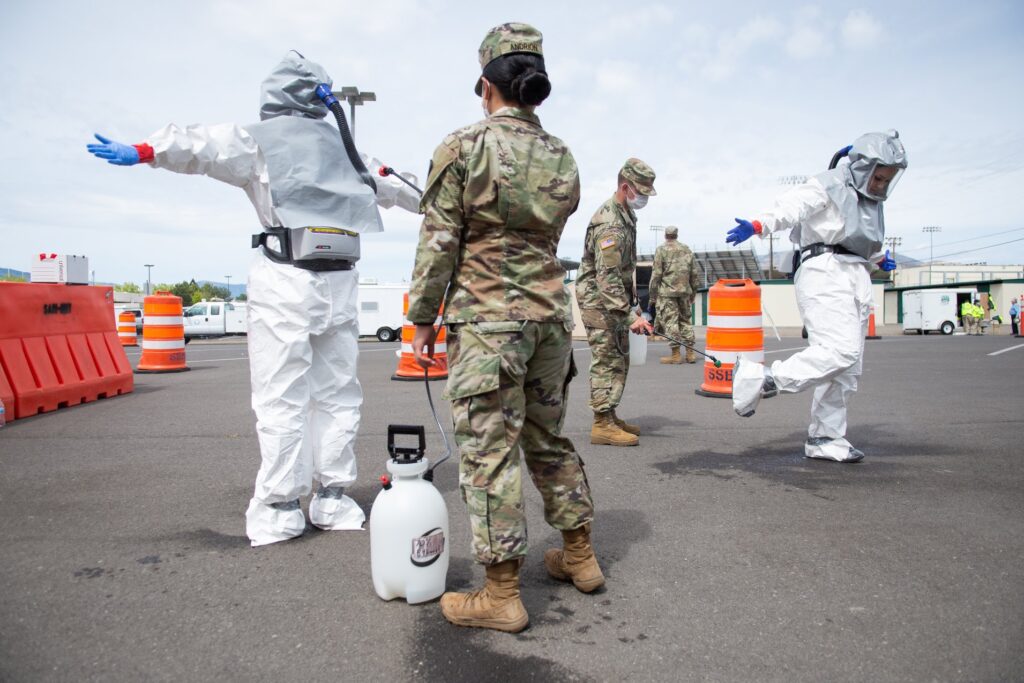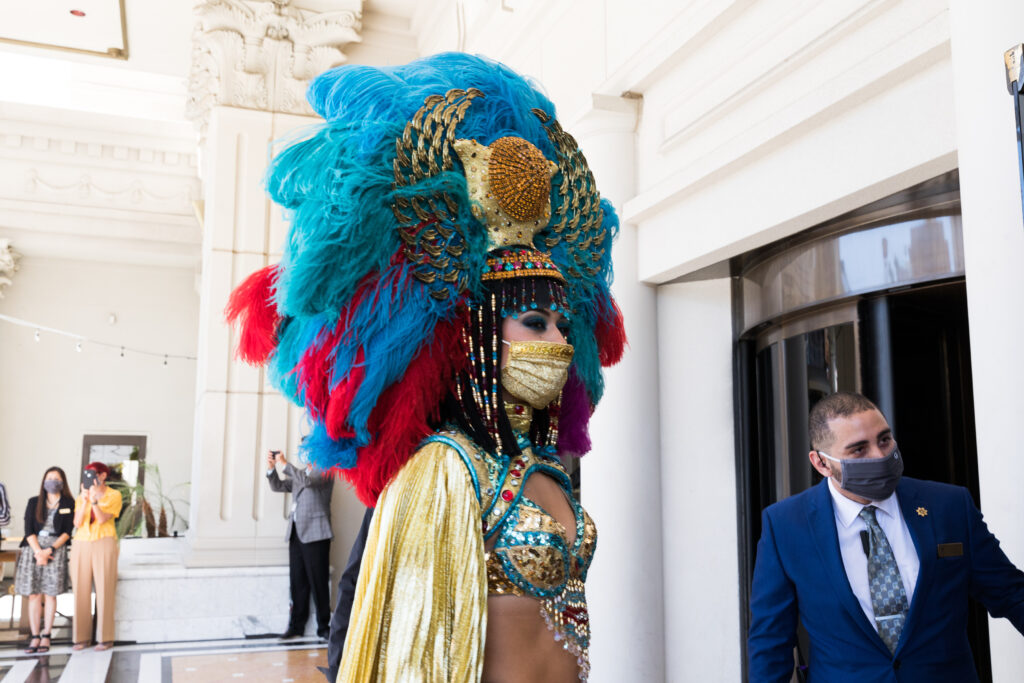The virus came to Nevada slowly, and then all at once.
At the beginning, it was a specter, a theoretical possibility but — public health officials optimistically thought at the time — an improbability. Nevada’s state epidemiologist, on Jan. 13, 2020, penned a report on the developing situation: Health officials in China had identified a novel coronavirus. There were 41 confirmed cases, all residents of Wuhan besides one recent visitor to the city, and one death.
“At this time there has been no evidence of person-to-person transmission, although there is still much to learn in regard to this novel virus,” state epidemiologist Melissa Peek-Bullock wrote in the report.
The primary focus from the Centers for Disease Control and Prevention, she said, was on standing up facilities at the three primary airports travelers to the U.S. from Wuhan pass through in New York, San Francisco and Los Angeles. All passengers from the city were to be screened upon arrival and, if unwell, referred to a hospital for further evaluation.
At that point, all state health officials here could do was communicate that information to local health authorities statewide and continue to monitor the situation. She wrote that the CDC believed the overall risk to the public was low.
The Silver State’s first brush with COVID-19 came nearly two weeks later. A Northern Nevada resident was transferred to a Bay Area hospital for isolation and monitoring after arriving in San Francisco from Shanghai with a cough, shortness of breath, fever and other flu-like symptoms. Her travel companion, who had not been stopped in California and made it back to Washoe County, fell ill too. Though neither of them had been to Wuhan, the first woman’s case was concerning enough to place them formally under investigation for the virus.
Fortunately, they were soon cleared after the first woman tested negative for COVID-19.
A few days later, a Southern Nevada man who had recently traveled to Wuhan was admitted to a local hospital after coming down with a sore throat, fever, cough, chills and body aches. He also tested negative.
The most dramatic early investigation centered around a Southern Nevada flight attendant who had been exposed to a confirmed COVID-19 case while on the job. Health officials had instructed the man to isolate; instead, he traveled with his family to Los Angeles, where he came down with a cough. Health district officials told him not to fly back to Las Vegas. He refused. They suggested he drive back. He refused. They asked for his itinerary. He refused.
For two hours one February evening, state officials, CDC officials and health officials in Las Vegas and Los Angeles scrambled to secure a public health “do not board” order that would prevent the man from flying. Complicating things, because the man was a flight attendant, he could fly standby on any one of the many airlines that flies between the two cities — and his name wouldn’t appear on a flight manifest until he had boarded.
The “do not board” order came too late: State officials received a call from the CDC at about 8 p.m. The man had flown standby and had just landed in Las Vegas. The “do not board” order was issued just after he boarded the plane. But, once again, it ended up being just a close brush with the virus. Health district officials that night made contact with the man, who agreed to cooperate with their investigation and isolate in his home; four days later, he tested negative for COVID-19.
This game of whack-a-mole continued for several weeks as it became clear that finding COVID-19 in Nevada was not a matter of if but when.
State and local health officials from across the nation, during a call on Jan. 26, shared their concerns about asymptomatic spread of the virus; China had reported that such spread was occurring, but the CDC had been unable to confirm. The possibility of asymptomatic spread was important because it meant that a traveler or multiple travelers could have unknowingly already brought the virus to the U.S. With little to no testing available at the time and extreme restrictions in place on how tests could be used, health officials would have no way of knowing to what extent the virus was already here.
Health officials on the call discussed the possibility of school closures and requiring employers to allow remote work, measures to help halt viral spread. But there was still so much they did not know about the virus.
“It was emphasized that decisions are required to be made with a lot of uncertainty and limited knowledge of the infectious period, overall infectiousness and sustainability of transmission and severity of this novel virus, so decisions need to be cautious and re-evaluated as we learn more about the virus,” Peek-Bullock wrote in one of her daily reports about the call.
A month later, a virus that had once been a point of interest was now a cause for concern. Fourteen cases had been identified in the United States, including two cases of person-to-person spread, while an additional 39 people with the virus from the Diamond Princess cruise ship and Wuhan had been repatriated to the country. Nevada health officials held a call with representatives of local health districts, the state public health lab and the state hospital association to discuss federal guidance, testing capacity, hospital preparedness, isolation and quarantine and public messaging.
Peek-Bullock, in her Feb. 24 daily report, underscored the seriousness of the situation, bolding and underlining the following:
“During the weekly national call today, CDC emphasized their goals, stating we cannot stop every traveler now that sustained transmission is occurring outside of China, but it is important to continue to slow and continue to contain the spread in the U.S. CDC stated that we are to expect spread to occur in the U.S. and now is the time for states to assess their readiness and ensure they are prepared. They emphasized this is not expected to go away, and in fact is expected to escalate.”
In short: The virus was here in the U.S., even if we hadn’t found it yet in every state. The only option now: Slow it down.
Four days later, Gov. Steve Sisolak gathered together more than two dozen of the state’s top government and health care leaders — state health officials, hospital representatives, local health district leaders, congressional staffers and education officials among them — in a crowded, standing-room only conference room at the Grant Sawyer State Office Building in Las Vegas. More joined from Northern Nevada by phone.
It was a meeting of the minds, so to speak, except that many had never actually met, according to some who attended. But in the coming weeks and months, their names would be familiar throughout the state: There was Dr. Mark Pandori, head of the state public health lab; Dr. Fermin Leguen, head of the Southern Nevada Health District; and Christopher Lake, the public face of the hospital association on all things COVID-19.
Despite the growing seriousness of the situation, those in the room didn’t have any idea just how quickly things were about to change, how bad it would get or how long it would last.
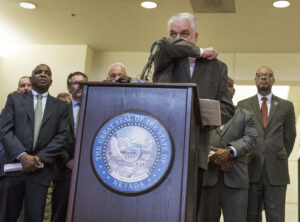
Afterward, the group descended to the building’s lobby, where they huddled behind Sisolak for his first press conference on COVID-19. He stressed to the public three things: That there were no confirmed COVID-19 cases in Nevada, that the immediate health risk from COVID-19 was low and that there had been no COVID-19-related deaths in the United States.
He did, however, note that more COVID-19 cases were likely to be identified.
“We’re going to prepare, not panic,” he said. “We’re going to choose collaboration over chaos.”
Six days later, on March 5, Ronald Pipkins became the first Nevadan to test positive for the novel coronavirus.
It was the beginning of, perhaps, the most difficult year in Nevada’s history, one that would lay bare the chronic underfunding of public health systems, a lack of investment in aging state infrastructure, including its unemployment system and continued economic overreliance on the tourism industry.
It was a year that would see 1 in 10 Nevadans test positive for the virus and more than 5,000 lose their lives to it, more than all U.S. military casualties in the nearly nine-year Iraq War.
It was a year that would see a quarter of Nevadans unemployed, as the state’s economy came to a sputtering halt last spring in an attempt to stop the spread of the virus. It was a year that would see a sharp rise in depression, anxiety and substance abuse in a state that already struggles to provide mental health services to its residents even in good times.
It was a year that would pit the state’s public health needs against its economic ones, every day a Sophie's choice.
It was a year that would see Sisolak come under heavy criticism for not communicating with the public well enough, for not bringing local governments into the fold early enough and for making policy decisions that seemed, to some, arbitrary and capricious, infringing on their individual liberties.
It was a year that would sow deeper divisions in a state with a long history of bipartisanship that’s increasingly been tested in the last few years. It’s a year that would see rural communities refocus their longstanding mistrust of government from the federal level to the state.
It was a year that would see Nevada’s health care providers pushed to their limits, overwhelmed, scared and at a loss for how to best care for their patients. It’s a year that would see Nevada’s fragile health care system pushed to its limit, too, and, surprisingly, not break.
It was also a year that would see resilience in the face of despair.
It’s a year that would see rank-and-file public health officials work harder than ever under the most scrutiny they had faced in their lives.
It was a year that would allow Nevada to take advantage of its relative nimbleness and lack of bureaucracy and move quickly to devise innovative solutions to meet the state’s needs, even when those solutions didn’t always work out as expected.
It was a year that would make clear to many that Nevada, as divided as it is, is still, at its heart, a scrappy Western state whose residents are accustomed to fighting for survival against the odds.
This is the story of that year.
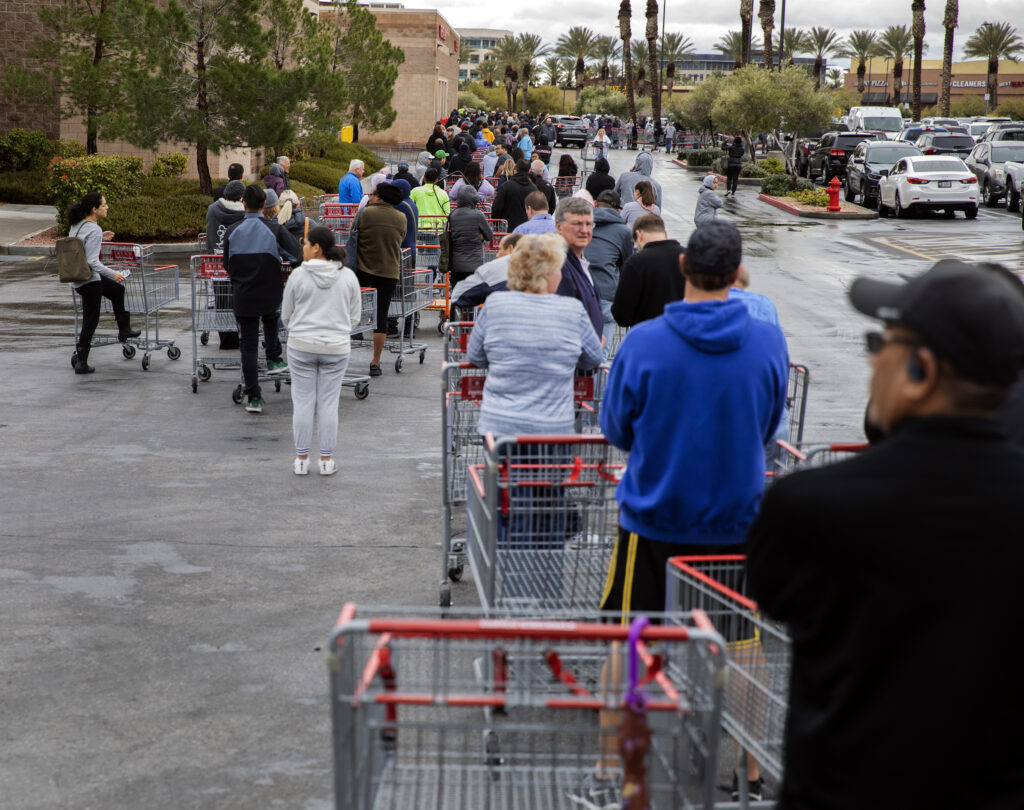
Shoppers wait in line at Costco in Summerlin on Friday, March 13, 2020. (Jeff Scheid/The Nevada Independent) 
Enrique, who was evicted from his home, holds the keys to his truck in a Las Vegas neighborhood on Thursday, Nov. 12, 2020. (Daniel Clark/The Nevada Independent) 
Volunteers work at a food distribution site at the Martin Luther King Development Center sponsored by Acelero Learning and Three Square on Thursday, June 11, 2020. (Jeff Scheid/The Nevada Independent)
Early in January 2020, public health experts didn’t see much reason to worry.
There are outbreaks of disease all the time, and a novel coronavirus in of itself wasn’t necessarily concerning.
SARS and MERS, two novel coronaviruses that surfaced in 2003 and 2012, respectively, claimed relatively few lives despite their high levels of mortality, in part because their spread was typically associated with symptomatic individuals. That meant that isolating people who were ill was very effective in containing spread. Plus, there are a bunch of everyday coronaviruses that circulate through the general population that only cause the common cold.
“There are weird things always popping up all over the world, and most of them don't turn into anything,” said Brian Labus, an assistant professor of public health at UNLV and former senior epidemiologist for the Southern Nevada Health District. “That's why it's hard to get really excited early on when you hear about some new virus like this because most of the time they do not spread that easily from person to person, which means we're not going to have a big outbreak.”
Public health officials started to take the virus more seriously, though, as more information came to light about it, including the fact that it could be transmitted person-to-person and spread by people showing no symptoms.
On Feb. 11, Nevada State Public Health Lab officials validated the CDC’s assay, meaning that they now had the capability to test for the virus at their lab in Reno. It was the same day the virus received its official name from the World Health Organization. It would be labeled SARS-CoV-2, and the disease caused by it would be called COVID-19.
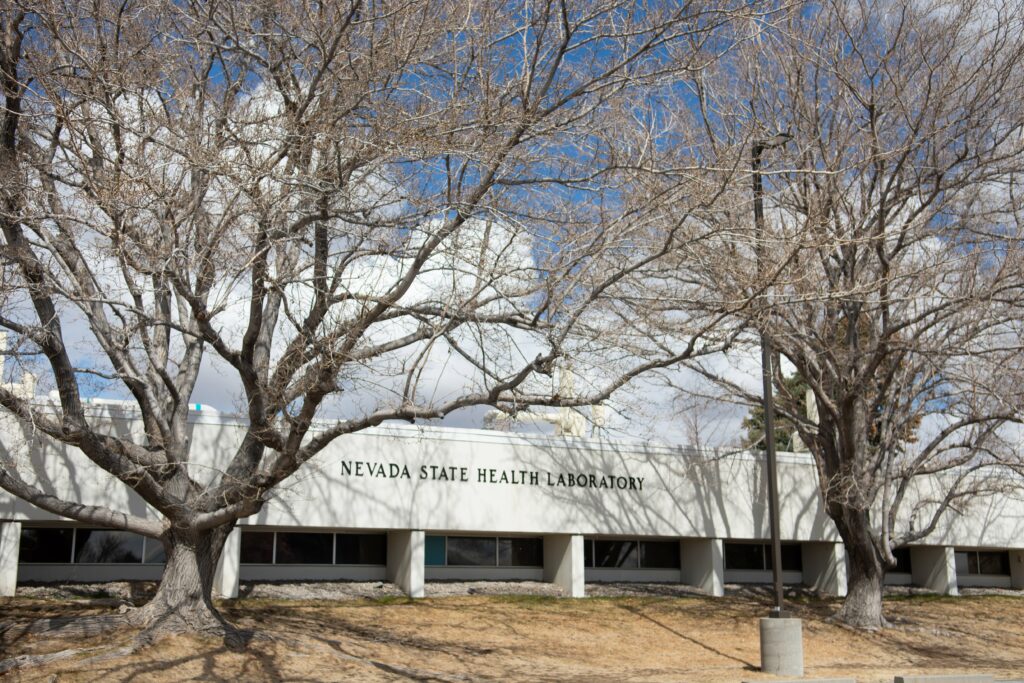
The outside of the Nevada State Public Health Laboratory on the campus of the University of Nevada, Reno on Thursday, March 19, 2020. (David Calvert/The Nevada Independent) 
A lab technician works at a station at the Nevada State Public Health Lab in Reno on Friday, May 8, 2020. (Joey Lovato/The Nevada Independent) 
Results of coronavirus tests from Panther machines at the Nevada State Public Health Lab in Reno on Friday, May 8, 2020. (Joey Lovato/The Nevada Independent)
Lab officials, though, didn’t want to sit around and wait for the virus to come to them. They were already having conversations with the Washoe County Health District about whether they might be able to start looking for COVID-19 in samples already at the lab that had been collected to be tested for other respiratory illnesses. So much of the focus to that point had centered around testing symptomatic people who had relevant travel history or were close contacts of confirmed cases. Northern Nevada health officials wanted to know if the virus was already here.
But, at the time, the CDC had strict rules about how the test could be used, namely, to test those with travel history or contact. That would’ve made sense, public health experts say, if the virus had behaved more like SARS. But even by that point in February, there were indications the virus was spreading asymptomatically, even if the role of asymptomatic transmission was still unclear.
That meant that Nevadans sick with respiratory illnesses might have COVID even without a relevant travel history or confirmed close contact.
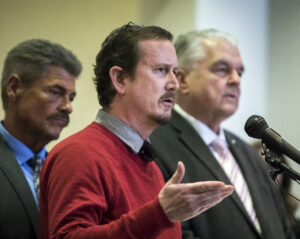
“It's not that I'm trying to point fingers or make fun of anyone, but we already knew how ridiculous that was then,” said Pandori, the lab’s executive director. “The chief [epidemiologist] of Washoe County and myself already wanted to start looking, but we had to wait.”
Heather Kerwin, Washoe’s chief epidemiologist, believes Nevada might have been able to identify cases a few weeks, if not an entire month, earlier had officials been allowed to start screening respiratory specimens for COVID-19. Pandori said it is “very easy to hypothesize” that earlier surveillance testing could’ve had an impact on the trajectory of the virus.
“When you don't react quickly to something or as quickly as you can, from a surveillance perspective, it's essentially a fact that you allow it to make headway or to spread in a manner that you might have had an opportunity to intervene,” Pandori said.
But, at that point, the federal government, at the highest echelons, wasn’t taking the virus seriously. President Donald Trump, at the White House on Feb. 10, said the country was in “great shape” and suggested the virus would disappear “in April with the heat, as the heat comes in.” Two weeks later, he said the virus was “very much under control in the USA” and that the country had had “very good luck.”
We still don’t actually know how early COVID was circulating in Nevada. When the antibody test for the virus came out last spring, the state lab tested old blood samples they had stored from December 2019 and January 2020 but didn’t find any antibodies for COVID-19. Some studies have tried to extrapolate how early the virus was spreading in Nevada and elsewhere across the country. One projects the virus was already spreading in Nevada by mid-February and puts the state among the first 10 to have community transmission.
Doctors here, based on what they now know about COVID, believe they were seeing cases as early as January. At the time, they chalked it up as a particularly severe flu season.
“In January, we were seeing tons of people with flu-like illness, and we were calling it the flu,” said Dr. Scott Scherr, the regional medical director for TeamHealth, which manages five emergency departments in Las Vegas and one in Elko. “When you look back at it, it wasn’t flu at all. It was COVID.”
In those early days, it wasn’t yet clear what kind of an impact the virus would have on Nevada, but government officials and the health care industry were starting to prepare. Clark County started updating its emergency plan. Hospitals started to think through the difficulties they might face in securing personal protective equipment, much of which is manufactured in China. They also dusted off their mutual aid agreements, which let them lean on each other for support in a crisis situation.
What was clear though, by the end of February, was that COVID was coming. For Las Vegas, a city that hosts nearly 50 million visitors a year, the virus was always just a short drive or plane flight away.
“We understood that it had all the makings to be a large scale, global pandemic at the time,” Peek-Bullock said. “But early in January and February, I don't know if any of us would have predicted where we would be sitting here a year from now.”
The situation escalated quickly: Concern became alarm.
On March 5, Nevada went from zero COVID-19 cases to two: Pipkins and a Washoe County man in his 50s who contracted the virus after sailing aboard the Grand Princess cruise ship. Though government officials, public health entities and health care workers had been preparing for the last few weeks, the first two cases brought the seriousness of the situation into sharp focus.
“Once we had the ability to really start identifying cases, those case counts grew very quickly,” Peek-Bullock said. “We know now the virus is transmitted very efficiently person to person, so I think that from our perspective, it really ramped up quickly for us too.”
Within a week, two cases had become 11, and health officials here knew that as they continued to test they would only find more cases.
Publicly, state and local officials put on a brave face: Yes, more cases might be identified. But if Nevadans did their part — avoiding contact with sick people, cleaning surfaces and washing their hands — we would get through this together. After all, Nevadans had leaned on each other in the aftermath of the mass shooting on the Las Vegas Strip two and a half years earlier. Why would this be any different?
“I encourage all Nevadans to prepare, not panic, and to continue to choose to collaborate over chaos,” Sisolak urged at a press conference two days after the first cases were announced.
But panicking happened anyway. Grocery store shelves were stripped bare as Nevadans, and those across the country, stocked up on toilet paper and canned goods, unsure of what was to come.
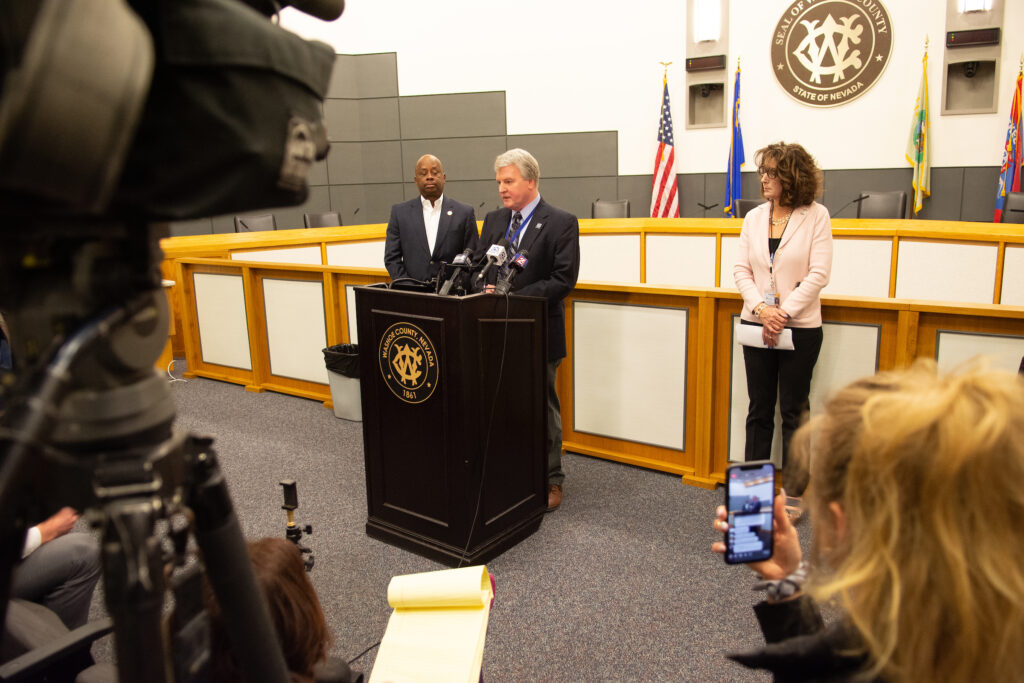
Washoe County District Health Officer Kevin Dick hosts a press conference to address the county's first COVID-19 case at the Washoe County Administration Complex in Reno on Friday, March 6, 2020. (David Calvert/The Nevada Independent) 
A shelf that normally holds toilet paper sits nearly empty inside a Henderson Target store as a result of growing fears about COVID-19 on Friday, March 6, 2020. (Daniel Clark/The Nevada Independent)
Behind the scenes, the governor’s office was assessing whether it had enough body bags and having conversations about air quality control standards should the furnaces in the crematoriums start burning overtime. In the governor’s office, a chart on the office wall showed the cases increasing day by day, doubling and then tripling. What they needed was more information, more guidance. Enter the governor’s Medical Advisory Team.
Dr. Paul Sierzenski, chief medical officer of the acute care services at Renown, was in the parking lot of Raley’s one day in early March when he got a call from the governor’s office asking him to join a new five-member advisory team Sisolak had established to help guide his decision-making.
The group’s first meeting was March 14, and the governor’s objectives, according to the meeting’s minutes, were straightforward yet seemingly impossible: He wanted to, one, figure out how to help identify individuals with COVID-19 and, two, define goals for the state to contain and mitigate the spread of the virus.
The governor’s office, the minutes note, wanted guidance only on one initial objective: “How do we inform the governor to make decisions on social distancing, mass gatherings, school closures, based on logic and facts for containing, mitigating, preventing?”
The members of that team, in interviews, praised the science-based approach and the decision to bring them — some of the state’s top minds in public health and infectious disease — into the fold so early on. The group still provides advice to this day, though it doesn’t meet nearly as frequently as it did in March and April last year, when it convened almost daily.
But there was one big problem: The Medical Advisory Team knew about as much about this novel virus as the rest of the public did. Sure, its members were familiar with SARS and MERS. They grasped influenza pandemic planning. They knew the playbooks on what they were supposed to do. But knowing what to do and figuring out how to do it are two entirely different things, they quickly learned.
“We had the plan but not the infrastructure,” said Trudy Larson, dean of the School of Community Health Sciences at UNR and one the members of the governor’s Medical Advisory Team. “This is so new for us as a country. No matter how much we wanted to, we really didn’t know all the pieces to put in place and, really, because of some of the social disruption that the country had gone through, we also didn’t have a common way of looking at these things.”
Caleb Cage, former head of the Division of Emergency Management under Gov. Brian Sandoval, who was pulled in to assist the Sisolak administration’s response to the pandemic, felt similarly. Though the state had previously participated in exercises to drill the state’s pandemic response such as Operation Rabbit’s Foot in 2015, Cage said that nothing could’ve prepared them for what it would be like to live through the last year.
“I’m not saying it is bad training and a bad exercise, but it certainly doesn’t stand up to the experience that we’ve had over the last nearly a year,” Cage, the state’s COVID-19 response director, said. “The stakes are real. In an exercise the stakes are, ‘Oh, you learn a lesson and you don’t do it again next time.’”
Part of the problem was, as the governor was asking his Medical Advisory Team big, important questions about how to respond to the virus, the members were themselves still trying to answer basic questions: How easily does the virus spread? What’s the death rate? What will actually stop the spread?
Those in the governor’s office said they were sure the answer — whatever it was — would be found in science: They believed in science. They trusted the scientists. They wanted to do what the scientists said.
“I think there's always this mindset that we will figure this out, that we will figure out a way as a country to control this and get a handle on it,” said Michelle White, the governor’s chief of staff. “I think that was the expectation of all Americans, that that's what we do, that we will get a grip on this and figure out a way to keep it controlled.”
The virus, however, had other plans.
When Nevadans awoke the morning of March 18, the roar of everyday life had dulled to a quiet murmur. School playgrounds were empty. The state’s four-mile-long adult playground was empty too as casinos famed for never closing chained their doors and boarded up their windows.
Slot machine screens blinked blue. They were out of service, and Nevada was too.
The writing had been on the wall. Two days earlier, schools in Nevada and 25 other states closed their doors, the rest to follow suit in the days to come. By the time Sisolak announced all gambling in the state would cease as the clock struck midnight on St. Patrick’s Day, several major resorts were already in the process of shutting down their operations, facing a wave of canceled bookings. Other nonessential businesses were given until noon to close up shop.
A bevy of people — public health experts, doctors, epidemiologists, business owners and representatives of various sectors of the economy — had provided their input to Sisolak and his staff in the days and hours leading up to the shutdown. But the decision was Sisolak’s alone to make. White said it was an “excruciating” process.
“At some point, when you’re the leader and everyone’s looking at you, you have to make that choice and you know it’s going to be massively consequential and you know that it is going to be applauded or it is going to be booed by all sorts of people and that that doesn’t matter at some point, that you just have to do what you think is best with the information you have in front of you,” she said.
Sisolak, in an interview, recalled walking out onto the balcony of his office at the Grant Sawyer Building in Las Vegas one evening in early March and looking out at the lights of the Strip.
“I’m saying to myself, if I shut this down, those lights are all going to go dark and 100,000 people are going to be out of work and kids aren’t going to be able to go to school, and I thought about the potential ramifications of what those decisions would be,” Sisolak said, choking up. “I came in and I said, ‘I’ve got no choice, we’ve got to shut it down,’ because too many lives were at risk.”
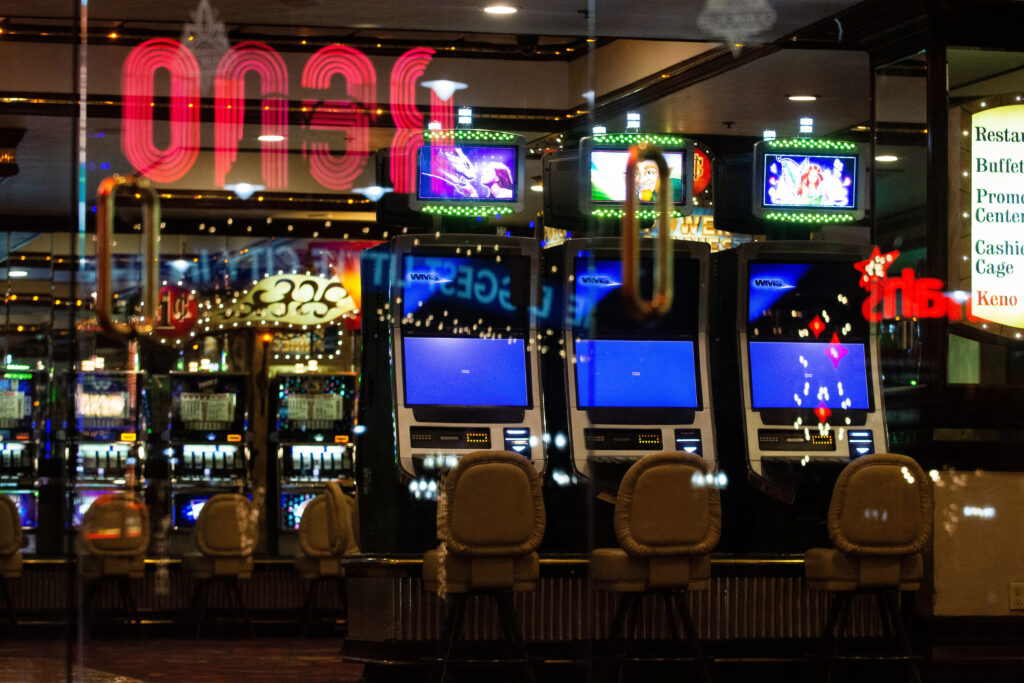
Gaming machines blink blue inside the Eldorado Resort Casino in Downtown Reno just before midnight on Tuesday, March 17, 2020. (David Calvert/The Nevada Independent) 
An empty beverage container as seen on the Las Vegas Strip after gaming operations were ordered closed by Gov. Steve Sisolak on Wednesday, March 18, 2020. (Daniel Clark/The Nevada Independent) 
A worker cleans a pedestrian bridge on the Las Vegas Strip after gaming operations were ordered closed by Gov. Steve Sisolak on Wednesday, March 18, 2020. (Daniel Clark/The Nevada Independent)
His primary focus, as he made clear at the time, was the public health crisis at hand. Back then, public health officials didn’t even know how deadly COVID was. Because of limited testing early on, data out of New York City, which was hit early and hard by the virus, showed that nearly 1 in 10 New Yorkers who had tested positive for the virus died from it. Some health experts were recommending people clean their groceries and packages because of concerns about surface-to-surface transmission. Little had been confirmed about the role of asymptomatic transmission.
At a press conference announcing the business closures, many questions focused on cause and effect: Would businesses face penalties if they remained open? How would the government police it? Sisolak, however, seemed irritated.
“I don't know if I can make this any clearer ... This is affecting the lives of our citizens. People are dying. Every day that is delayed here, I'm losing a dozen people on the back end, they're going to die as a result of this,” Sisolak said, bristling. “It's incumbent upon the citizens of this state to take this seriously. Next question.”
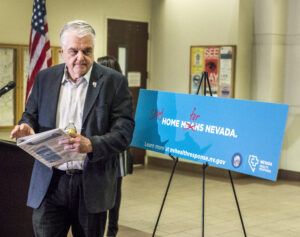
It’s not that the governor’s office wasn’t aware of the economic consequences of shutting down and how many Nevadans’ lives would be affected. But the public health crisis seemed so daunting and the shutdown so necessary to get the virus under control.
Furthermore, the shutdown was billed as a short-term situation. The school closures were initially supposed to last only three weeks. Businesses were to be closed only for 30 days. But the virus stubbornly lingered as hospitals scrambled to secure resources and learn how to treat this new disease.
At the beginning of April, Sisolak put in place a “stay at home” order, formalizing what had existed in spirit for several weeks and extended the closures of nonessential businesses and schools. By the middle of the month, the shutdown had been extended to an undetermined date and schools closed for the rest of the academic year.
“It’s a symbol of truly no one really knew how long this was going to last for,” White said of the early emergency directives. “It was this immediate decision making needed to protect the health of the public in that moment.”
Everyone wanted certainty in that time, from everyday Nevadans to the governor himself. Everyone wanted to know that if only we did X, then all of this would be better. But we didn’t know what X was. In those months, the entire world was still solving for X.
“We want to be able to say, ‘This one is 100 percent foolproof,’ and oftentimes in this situation, the options that we had to lay out on the table — not only is it not always a no-win situation, it is, how do we lose the least?” White said. “How do we do the most good for the most people, understanding that each one of these choices is going to have a negative impact on someone or something somewhere?”
At the worst point in April, statewide unemployment hit 28.2 percent, climbing to 33.5 percent in Las Vegas. Today, 1 in 4 Nevadans is enrolled in Medicaid, the state’s insurance program for low-income individuals and families, up from 1 in 5 before the pandemic.
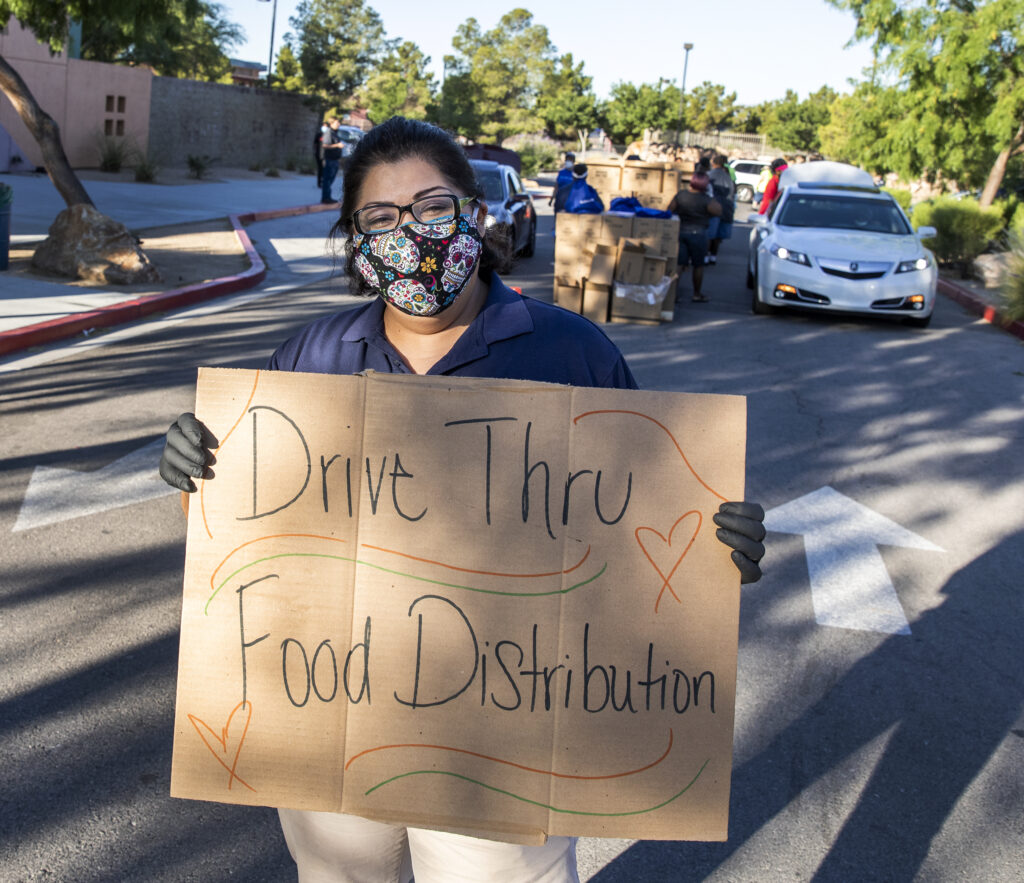
A volunteer holds a sign at a food distribution event at the Martin Luther King Development Center sponsored by Acelero Learning and Three Square on Thursday, June 11, 2020. (Jeff Scheid/The Nevada Independent) 
A sign tells visitors that Logan Shoals Vista Point is closed because of the COVID-19 pandemic as seen on Saturday, May 9, 2020. (David Calvert/The Nevada Independent) 
A line as seen outside a Target store in Henderson on Wednesday, March 18, 2020. (Daniel Clark/The Nevada Independent)
State officials and public health experts say it can be easy to criticize these early decisions with the benefit of hindsight. We now know the virus is not as deadly as we initially thought, though still more deadly than the flu. We also know that COVID got much worse in Nevada this fall than it ever did in the spring. When Sisolak closed nonessential businesses in March, there were only 55 confirmed COVID-19 cases statewide. At the worst point in the pandemic this fall, the state was identifying more than 2,700 new cases a day. But they say that lessons learned during the spring shutdown and the time it bought the state were precisely what allowed many businesses to remain open, at least to some extent, this fall.
Had we known back in March what we know about COVID today, those who helped advise the governor said, they might have made different recommendations about closing businesses and schools. But thinking back to what they knew at the time, they — and the governor himself — believe that shutting down was the only option.
“It was really just a lot of unknowns that led us to all we could do to stop the transmission,” Labus, one of the members of the governor’s Medical Advisory Team, said. “Nobody knew what was going on with this particular virus. We were still trying to understand it.”
In late March, as the refrigerated trucks began to pull up to New York City hospitals, Nevada — a state where people sometimes grimly joke that the best health care you can get is at McCarran, the airport, leaving town for a city with world class medical care — braced for an onslaught.
Health officials worried that if New York City, which has some of the most hospital beds per capita of anywhere in the country, couldn’t handle COVID, how would little Nevada fare, particularly its rural residents, some of whom live more than 100 miles from the nearest hospital?
“If they couldn’t handle it there, we definitely couldn’t handle it in Nevada,” Labus said.
Sisolak temporarily placed the state’s Department of Health and Human Services and Division of Emergency Management under the direction of Major General Ondra Berry, adjutant general for the Nevada National Guard.
It was an operation completely unfamiliar to the Guard. In some ways, it was easier: Guard members weren’t deployed overseas and could return home to their families every night. They didn’t have to face the day-to-day horrors of war. In other ways it was more difficult: They faced the danger of bringing the virus home to their families, as the death toll mounted quickly.
Berry likened the daily COVID death reports on the nightly news to the daily casualty reports they’d get during the Gulf War. Since March 26, at least one Nevadan has died from COVID-19 each day with the exception of one day. At the peak this winter, Nevada lost 47 in a single day.
“It may not be the same atrocity that you may see in war, but you are in a battle for people’s lives,” Berry said. “If the best solutions are not in place, then those who we care [about] and love and matter may not get to see tomorrow. It’s a different kind of similarity, but it’s a fight.”
And it was coming. Nevada, the state born in the heat of battle, readied itself.
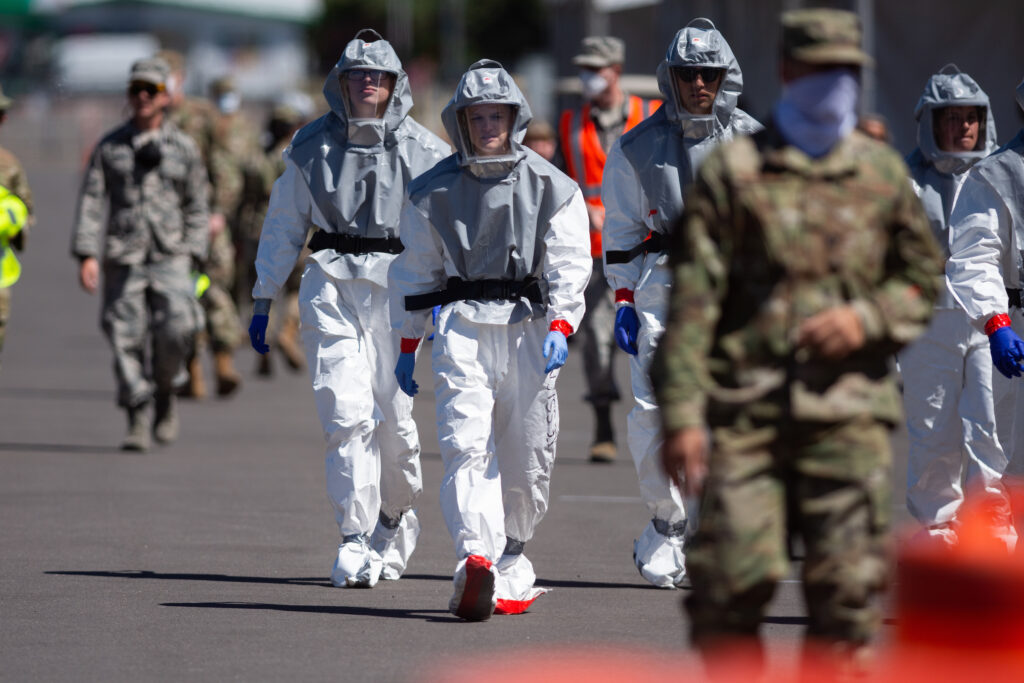
Staff gear up to work at the Washoe County Health District’s drive-through COVID-19 test site at the Reno-Livestock Events Center on Saturday, May 16, 2020. (David Calvert/The Nevada Independent)
When Pipkins tested positive for COVID-19 at the North Las Vegas VA Medical Center in early March, his doctors were in disbelief. It was the first novel case in the VA system nationwide. Higher-ups from Washington, D.C. called every day for an update on his case.
The initial treatments Pipkins’ doctors tried didn’t seem to work, so they did the only thing they could think to do — put him in a medically induced coma and hook him up to a ventilator to keep him breathing while his body continued fighting.
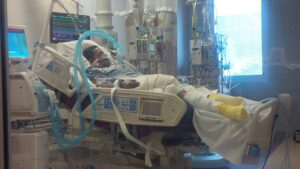
“That’s all that we had at the time. That feeling as a physician — especially when people would come to us and say, ‘Hey, listen, you’re the expert. What can you do to make me better?’ — I had no good answer at the time. All I could say is, ‘Listen, I can keep you alive until something happens, but that’s the best that I can do,’” said Dr. Myron Kung, a pulmonary critical care physician at the VA hospital and one of Pipkins’ doctors. “That’s a frightening position to be in as a provider.”
Kung said he was learning more and more about the virus watching CNN, just like everyone else was.
Scherr, the emergency medicine physician, recalled patients flooding into the ER in March and April struggling to get enough oxygen; doctors’ first instincts were to intubate them and place them on ventilators to keep them breathing. Just as state officials were working with the best information they had at the time, so, too, were doctors struggling to fight a virus with what they knew. Though patients’ chances of surviving significantly dropped once they were ventilated, it still gave those like Pipkins a fighting chance.
The problem was, what would they do when they ran out of ventilators?
“In the beginning of it, our ICUs were full,” Scherr said. “Our ventilator capacity was near 80 percent.”
Once the state effectively shut down, the numbers started to drop. A peak of 711 COVID hospitalizations in early April plummeted to 421 just a month later. In the same timeframe, the state went from having 240 COVID patients on ventilators to only 115.
Doctors, nurses and hospital officials across Nevada say that initial shutdown — painful as they know it was for so many of their friends, family and fellow Nevadans — bought them critical time to prepare. They secured additional resources, including personal protective equipment and ventilators, set up additional bed space and learned more about the virus and how to treat it. That decision, they say, saved an untold number of lives.
It’s impossible to know exactly how many lives Nevada might have lost had it acted differently. If Nevada were New Jersey, which like New York was also hit early and hard by COVID, it would’ve lost more than 8,000 of its residents to the virus. If it were Mississippi, which has taken a relatively lax approach to COVID restrictions, it would’ve lost 7,000.
To date, Nevada has lost more than 5,000 lives to the virus.
“When we first started seeing that surge of COVID, there was not a single hospital in the [Las Vegas] valley that was ready to deal with that,” said Dr. Shadaba Asad, UMC’s medical director of infectious disease and another member of the governor’s Medical Advisory Team. “If the city had not been shut down and that spread of infection had not been halted, or at least reduced, I think it would have resulted in a catastrophe where our hospitals would not have been able to take care of the patients who became ill.”
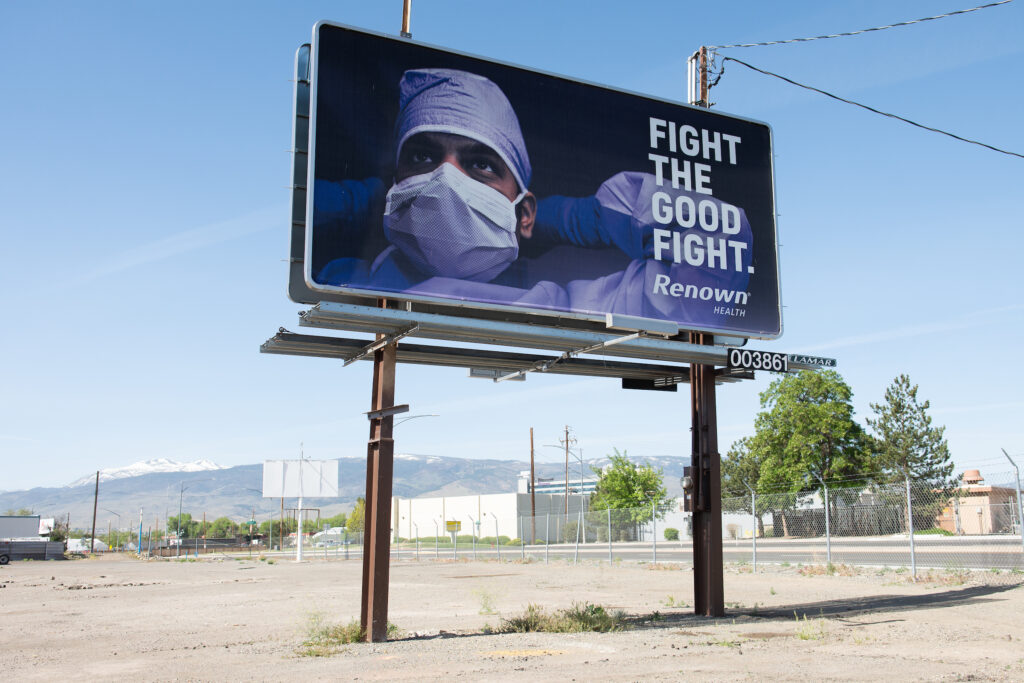
A billboard advertising Renown Health as seen in Reno on Saturday, May 9, 2020. (David Calvert/The Nevada Independent)
Early on, hospitals were focused on making sure they had the bed space and staff to handle a sudden influx of COVID patients, who typically require lengthy hospital stays. There were two ways to accomplish that: Facilities could either increase bed space, as Renown did when it made the decision at the end of February to set up an alternate care site in its parking garage, and bring on additional staff, difficult when states were competing for a limited pool of traveling nurses, or they could decrease the number of patients in the hospital, thereby reducing the number of beds and staff needed.
While some hospitals focused on the former, Nevada hospitals statewide did the latter, suspending all non-urgent surgeries. That means people who needed hips replaced could not get them replaced and people who needed tumors removed at some point in the near future could not get them removed.
“It’s really with a heavy heart that you make that decision that we’re going to stop that,” said Lake, executive director of community resilience at the Nevada Hospital Association, which announced the suspensions back in March. “It’s not a financial decision, it’s really a triage decision.”
Nevada hospitals, like those everywhere else in the world, also struggled to secure personal protective equipment (PPE) for their workers as global supply chains collapsed and the cost of basic, necessary medical equipment like masks, gloves and surgical gowns skyrocketed. Because testing was so limited early on, hospitals had to treat every patient as if they might have COVID. So did first responders. That meant expending significant amounts of PPE on every patient — PPE that had quickly become the scarcest resource.
“It was sort of like a shark feeding frenzy with blood in the water,” Lake said.
The situation got so bad that the first mission of a private-sector task force established by the governor to assist with the state’s COVID response raised $10 million dollars to purchase personal protective equipment, including 2 million N95 masks, 2.6 million surgical masks, 1.5 million gloves and hundreds of thousands of face shields and goggles.
Meanwhile, in hospitals some workers say their facilities were keeping PPE under lock and key. Others tried to buy their own supplies and bring it from home. But the heart of the issue was that there just wasn’t enough available in Nevada, across the country or around the globe.
“I can’t even begin to explain this fear and dread even amongst health care providers when we started getting these first patients because it’s a highly contagious disease and knowing very little about it, being exposed to it day and night and not sure if we were actually protecting ourselves, if we were taking the disease back to our loved ones,” Asad said.
And time has borne out how important personal protective equipment is in protecting hospital workers. When Yarleny Roa-Dugan, a labor and delivery nurse in Las Vegas, fell ill to COVID in January 2021, it wasn’t because she had been exposed to a patient but rather to her carpenter husband, who they believe contracted the virus at work from someone who wasn’t wearing a mask and later tested positive.
On one level, the concerns over PPE were about protecting health care providers. But they were also making sure that hospitals had enough staff to treat all of their patients. If health care workers were already a scarce resource in Nevada before the pandemic, what would hospitals do if a significant portion of their workforce had to quarantine because of exposure to COVID or because they fell ill to the virus themselves?
When Pipkins came into the VA hospital in March, 47 employees who came into contact with him had to quarantine at home for 14 days because they weren’t wearing PPE.
“If you started quarantining health care providers exposed to people with COVID, before you knew it, you would have nobody to take care of these patients,” Asad said. “We started learning slowly, and this had primarily to do with availability of health care providers, if a health care provider was exposed to somebody with COVID, as long as they had absolutely no symptoms concerning for COVID, they were allowed to work with precautions, daily symptom monitoring and daily screening.”
The state shutdown also bought doctors critical time to learn how best to treat the illness. They discovered it was better to place patients on their stomachs and give them high flow oxygen for as long as they could bear, only putting them on a ventilator as the last resort. They started giving their patients steroids. They started using remdesivir, an antiviral drug, and convalescent plasma.
Spring, as it turns out, was just the beginning for Nevada’s hospitals. The state would see nearly twice as many COVID-19 patients hospitalized during the summer surge and three times as many during the fall surge compared to the worst point during the spring.
But doctors believe if not for the initial shutdown, they never would have been prepared for what was to come.
“It would have broken down the health care system completely and it would have resulted in innumerable, avoidable deaths,” Asad said.
If the goal had been solely to stop all spread of COVID-19, the best way to accomplish that would have been to lock every single person on the planet inside their home until everyone infected with the virus had either recovered or died from it.
This was, of course, never a realistic option.
Nevada’s lockdown, by comparison, was relatively porous. People were still allowed to go to the grocery store and pick up takeout. Workers in some essential industries, such as manufacturing and construction, were allowed to continue to go to work. Friends and family could still gather privately in small groups in their homes.
Still, some Nevadans may have been hopeful the lockdown would eliminate the virus and they would be able to emerge sometime in late spring or early summer and return to life as they knew it. State officials, however, knew that was not going to be the case. Their focus was mitigation.
They knew a lockdown couldn’t reasonably last forever, and they knew that cases would rise once it ended. That’s why, once the initial tide of COVID-19 cases started to ebb, their focus turned to figuring out how to reasonably stop as much spread of the virus as possible while also allowing Nevadans to do the things they reasonably needed to do to sustain themselves.
The answer was, on its face, simple: One, they needed Nevadans to continue to interact as little as possible to limit the spread of the virus; two, they needed all Nevadans who wanted to get a test to be able to get a test in the event they fell ill; and three, they needed to be able to contact trace all Nevadans exposed to the virus to prevent them from spreading it to more people.
But changing human behavior is a tricky, if not impossible, proposition. Plus, Nevada was already lacking in public health infrastructure prior to the pandemic, which meant it was nowhere near prepared to undertake a testing and contact tracing effort of this magnitude, despite best intentions.
Early projections suggested that states would need 30 contact tracers per 100,000 residents. That would mean Nevada would need nearly 1,000 contact tracers. State officials estimate they had 10, maybe 15, contact tracers at the time.
Other gaps quickly became apparent as well. State officials discovered early on that several counties, which are required by state law to have county boards of health, did not.
“I remember calling one sheriff in a rural county and saying, ‘Who's your county health officer? Tell me about your last board of health meeting,’ and he was like, ‘I have no idea what you're talking about,’” said Julia Peek, deputy administrator in the state’s Division of Public and Behavioral Health. “He scrambled to get it set up, to a ton of his credit.”
The state's two public health labs — the Nevada State Public Health Lab in the north and the Southern Nevada Public Health Lab in the south — were also ill prepared for something of this scope. Both labs were well-accustomed to testing for infectious diseases, foodborne illnesses and sexually transmitted infections on a small scale, but widespread testing for COVID-19 for every Nevadan who wanted it?
“I think people still don’t appreciate or understand that there was not and there still is not and there likely will never be an infrastructure whereby every person can get a test when they want it,” Pandori, head of the state public health lab, said. “Even with disaster and bioterror preparedness, which started to be financed pretty heavily after 9/11, in particular, that money does not come within a trillion miles of making labs and public health labs possible to test anyone who needs a test at any given moment.”
That didn’t stop Nevada from trying. Health officials knew that as soon as Nevadans were allowed back out in public again, the virus would start spreading and they would need a way to find it. The answer, for Southern Nevada, came from an unusual source: UMC, the county-run, safety-net hospital. UMC’s mission, as a public hospital, is to serve the community. In the time of the pandemic, that meant effectively joining the state’s public health response.
“Did I ever think we would be doing COVID testing and running a massive vaccination enterprise? Absolutely not,” Mason VanHouweling, UMC’s CEO, said.
Toward the end of March UMC realized it needed a better solution for COVID testing. It was still the tail end of the flu season, and the hospital couldn’t tell whether its patients were sick with the flu, COVID or both. From there, UMC started talking about how the hospital could not only expand testing for its own patients but also help with the demand for public testing, which was incredibly slow and scarce at the time.
So, the hospital shuffled its funds around, including capital it had originally intended for other projects, and made the decision to set up a second, complete lab that would be able to turn around test results within 24 hours and run up to 10,000 COVID tests a day. To date, UMC has run nearly a million COVID-19 tests across Nevada, about a third of the 2.7 million tests that have been run across the state. The lab ended up costing the hospital about $1.3 million to develop and $57.5 million to operate in labor and supplies.
While there were initially talks with the governor’s private sector task force about bringing in a Chinese company, BGI, to help to establish the lab — which the U.S. government warned against — VanHouweling said the hospital decided on its own to go a different direction.
Jim Murren, former MGM Resorts CEO and head of the state’s private sector task force, helped the hospital secure a contract with Thermo Fisher, a Massachusetts-based company, to provide open source, high-throughput test machines that would allow the hospital to use a wider range of supplies for the machines and meet the demand the hospital anticipated. He did so by selling them on the idea that the company would be able to pitch to its shareholders that their test supplies helped Las Vegas — and by promising them that they wouldn’t face a ton of red tape with the contract and that government officials would move quickly on the decision.
What’s still not entirely clear is why so much of the focus from government officials and the private sector task force was on helping UMC with their entirely new lab instead of assisting the Southern Nevada Health District in expanding its existing public health lab. The Southern Nevada Health District said the answer lies in the governor’s office. The governor’s office said it was just a matter of UMC being ready and willing to quickly step in to fulfill that role. Murren said it was because UMC’s lab was considered one of the best in the nation and that he was betting on VanHouweling, the Air Force veteran who turned the once-struggling hospital around.
“I bet on people,” Murren said. “I’ve done it my whole life.”
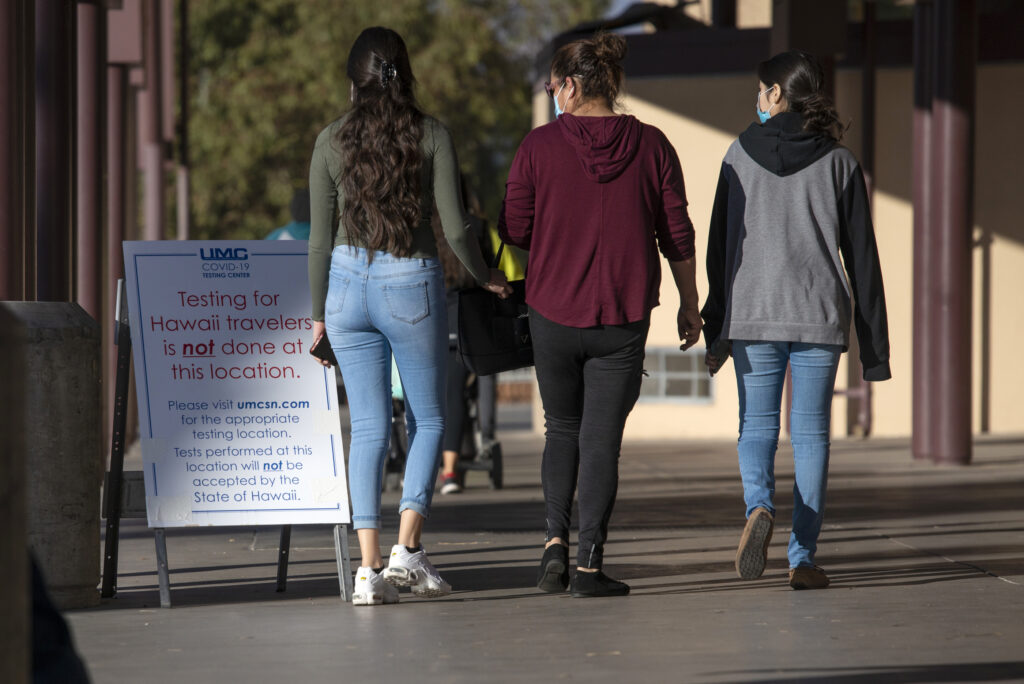
People walk into a University Medical Center COVID-19 testing center at Cashman Center in Las Vegas on Tuesday, Dec. 8, 2020. (Daniel Clark/The Nevada Independent) 
Signage seen inside a University Medical Center COVID-19 testing center at Cashman Center in Las Vegas on Tuesday, Dec. 8, 2020. (Daniel Clark/The Nevada Independent)
Renown, in Northern Nevada, ended up filling a similar public health role in its community by investing $3 million on expanding its testing infrastructure. At the height of demand, Renown was running 7,000 tests a week in a county with a population of a little less than 500,000.
The Nevada National Guard also played a critical role in establishing testing infrastructure statewide, both in urban Clark and Washoe counties but also in rural Nevada and on reservations where they facilitated mobile testing efforts.
“There's nothing in the National Guard playbook that talks about setting up a testing center,” Berry, the Guard’s adjutant general, said. “But these are people who bring a variety of skill sets to the fight every day and they just knew how to do logistics, they just knew how to do planning, they knew how to do communication ... Whatever they were tapped on the shoulder to do, they just figured it out.”
Testing alone wouldn’t halt the spread of the virus, though: Nevada would need to be able to trace the virus by making contact both with the people who tested positive for the virus and with the people they had potentially exposed. Early on, the state was inundated with pitches from vendors promising their platform would be the one to solve all contact tracing ills; it settled on contracts with Salesforce and Deloitte to ramp up a digital contact tracing system and workforce. Though state officials had received early indications that their local counterparts weren’t interested in a new system, the state was hopeful that if they built it, the health districts would come.
While those preparations in the spring set the stage for the state to start reopening, the coming months would push the newly expanded testing and contact tracing infrastructure to its limit. Public health experts say the expectation that the state would be able to test every Nevadan who wanted to be tested and trace every Nevadan who needed to be traced was too rosy, particularly in light of the tremendous case volume the state would see in the summer and fall.
“The way I describe contact tracing is that you're tracing down those embers of a fire, you're trying to put out the last part of it,” Labus said. “When the forest fire is raging, it doesn't make a lot of sense to find all those little embers.”
Still, as April turned to May, the state collectively breathed a sigh of relief. Cases were no longer exponentially increasing. Hospitalizations were on the decline. Testing had ramped up. Health care workers felt more equipped to treat the virus.
But it was still just the beginning. The wildfire was yet to come.
Reopening Nevada was easier said than done.
Shutting down was immensely challenging for businesses, but it was a relatively straightforward policy once it became clear what entities were allowed to stay open and what were not. Reopening, however, would not just be the reverse of closing. It would need to happen slowly and methodically, with an eye toward figuring out which businesses were the safest to open and how to mitigate risk in those deemed less safe.
Sisolak, at the end of April, announced the state would begin an “active transition” toward reopening. He emphasized that it would be done in a data-driven way and that the state would be required to see a “consistent and sustainable” downward trajectory in COVID-19 cases and hospitalizations, sufficient hospital capacity and health care workforce and the ability to test all symptomatic patients.
The governor laid out his reopening plan in a winding, 28-page document titled the “Nevada United Roadmap to Recovery” that strove to offer certainty to an uncertain public. It outlined a four-phase reopening plan complete with Nevada-themed nicknames for each phase: "Battle Born Beginning," "Silver State Stabilization," "On the Road to Home Means Nevada" and "Home Means Nevada — Our New Normal." Each phase would allow time for the state to reassess the data and make sure that it was on track before proceeding to the next phase of reopening.
The roadmap broadly laid out the contours of which businesses would be allowed to open in each phase. Outdoor spaces, small businesses and “select retail” would be allowed to open under the first phase with strict social distancing, hygiene measures and occupancy limits. But the finer points of which businesses, exactly, would be allowed to open and how were still yet to be determined.
That responsibility largely fell to a new Local Empowerment Advisory Panel, or LEAP, established by Sisolak to help counties assist businesses with safely reopening. The name made it sound, perhaps, more formal than it ended up being in reality.
How it actually worked was that three of the panel’s members — Clark County Commission Chairwoman Marilyn Kirkpatrick, Eureka County Commission Chairman J.J. Goicoechea, and Dagny Stapleton, executive director for the Nevada Association of Counties — would spend hours on the phone on the weekend brainstorming what guidelines they thought made the most sense, which Clark County staff would then spend hours typing up. They’d then send those over to the state Department of Business and Industry for a first review and then onto the governor’s office for final review.
“I'll tell you, it's super easy to close things down, it's very hard to open things up,” Kirkpatrick said. “You're trying to think of every single business and trying to put some common sense and public health in the same conversation so that people could navigate and be open and be open safely.”
The biggest challenge, though, was figuring out how to safely reopen casinos.
“If you look from purely a public health angle, the fact that our casinos are open seems like a really bad idea,” Labus said. “But, at the same time, that's what the economic basis of our state is, and there is going to be all sorts of public health fallout if we close them. People will lose their jobs, they'll lose health insurance, they won't be able to feed their families, all those kinds of things, and those cause health problems as well.”
Because keeping the casinos closed forever was not an option, the state focused on what could be done to open them safely. Conventions, at the beginning, were out. Table games, while not ideal, could be done with strict spacing requirements and other precautions. Other establishments inside casinos, like restaurants, would adhere to the statewide guidance for those kinds of businesses.
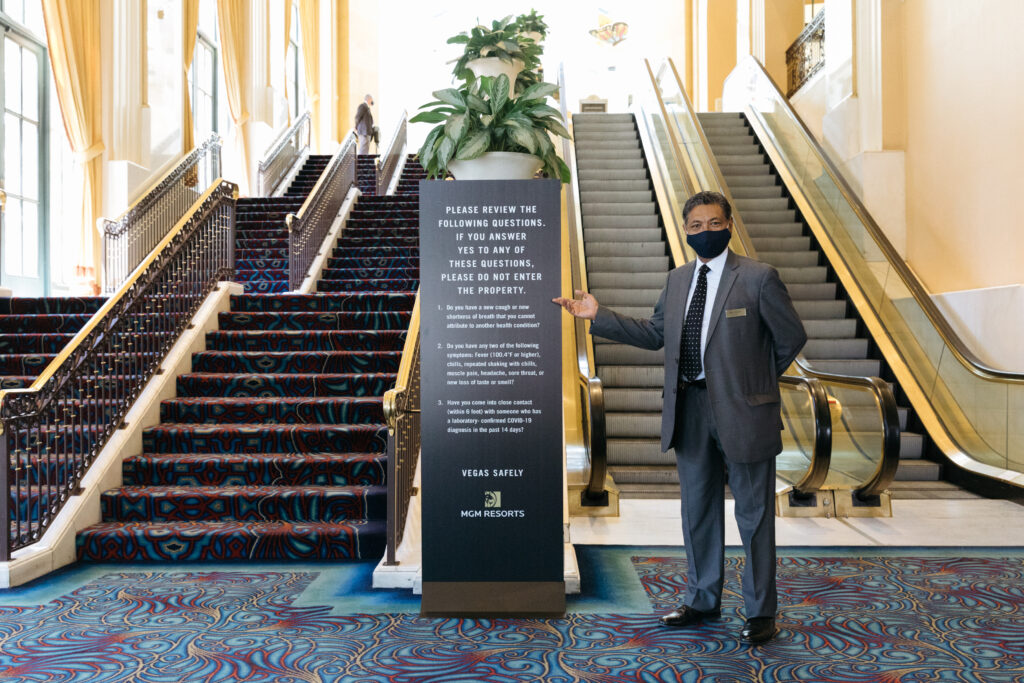
An employee welcomes and points out a sign with guidelines at the Bellagio after it reopened to the public on Thursday, June 4, 2020. (Mikayla Whitmore/The Nevada Independent)
Even public health experts from outside Nevada emphasize there isn’t necessarily anything riskier about a casino than any other establishment that brings large numbers of people together, so long as the appropriate mitigation measures are in place.
When it comes to data on points of exposure — an imperfect science for many reasons — hotels and casinos are not at the very top. Recent data show they’re behind restaurants and grocery stores in Southern Nevada.
“You can open a casino and, yes, you can put measures in place to make sure that you reduce it to a very low level of spreading,” said Ali Mokdad, an epidemiologist at the Institute for Health Metrics and Evaluation at the University of Washington. “To blame the casino and say, hey you guys have to do your part, and yes they have to, but also the community and everybody has to do their part.”
Both the state and the resorts had a vested interest in making casinos as safe as humanly possible. Resorts didn’t want to earn a reputation for being superspreaders, and the state worried about being put on other states’ travel blacklists, both of which would defeat the point of reopening casinos in the first place.
“We knew that it would be this tricky, delicate balance of wanting to make sure people could come here in the safest way possible at each time throughout this pandemic and protecting the reputation of the state, and particularly of Las Vegas, to make it a place where people felt safe coming and where other leaders across the country felt safe sending their own residents,” White, the governor’s chief of staff, said. “When people come here, it means Nevadans have jobs, it means Nevadans feed their kids, it means they can pay their electric bills.”
But, as safe as state officials and resorts could try to make the Las Vegas experience, bringing people together from all over the world is inherently a risky proposition. Just look at the polio scare centered around Mecca in 2005 or the superspreader conference in Boston that led to more than 300,000 cases of COVID-19.
“I would be concerned if I am a health official in Nevada, especially in Las Vegas, about who’s coming to us and what kind of variants and how much this will impact circulation of the virus in my community,” Mokdad said. “We’re not attacking the casinos, but we have proof that such events when people meet for a conference or for a wrestling game or a football game, it spreads the virus.”
For the many Nevadans who were unable to work from home this spring, the governor’s reopening plan was greeted with a sigh of relief. They would be able to go back to work. Their family members would be able to go back to work. Life would start returning to some semblance of normalcy. The four-step plan laid a clear path forward for the state.
On May 9, Nevada entered “Phase 1” of business reopenings, which allowed dine-in restaurants, hair salons and nail salons to open with capacity restrictions. Churches, gyms and bars were allowed to open as Nevada moved into “Phase 2” later that month. Finally, on June 4, tourists started to trickle back to Las Vegas as casinos once again opened their doors.
The “new normal,” it seemed, was within reach.
It was clear that cases were going to increase.
But what state officials perhaps didn’t fully comprehend as Nevada started down the path of reopening is how quickly they would do so as many Nevadans, who had for the most part been shut inside their homes for months, rushed back to their daily lives.
“It looked like, for a large proportion of people in our community, there was this sense of a kind of victory over the virus,” said Leguen, district health officer for the Southern Nevada Health District. “As you look back at the months of May, June and July and compare it with today, you will see there wasn’t that high level of compliance of people with mitigation measures, the use or masks, social distancing or the avoidance of public places. They felt at the time that the pandemic was over, everything is great, let’s go relax and party.”
At the low point in May, fewer than 100 people were testing positive for COVID-19 each day. By mid-July, that number had skyrocketed to more than 1,000.
Local health districts were quickly overwhelmed by the number of cases they needed to investigate and contacts they needed to trace. Before the pandemic, Nevada’s contact tracers were responsible for tracing relatively small outbreaks of illnesses. Even syphilis, which poses a significant public health challenge for Nevada, was nothing compared to COVID. There were only 2,000 cases of syphilis reported in 2018; over the summer, Nevada was seeing that many COVID-19 cases in two days.
While the state was able to step in and offer up its contact tracing platform and workforce, local health districts were still overwhelmed by the number of disease investigations — that’s the initial interview with a person who has tested positive for COVID-19 — they had to complete.
With the help of the Nevada System of Higher Education, the state was eventually able to scale up the number of trained public health professionals who could do disease investigation and contact tracing work. But it took time and, in the meantime, people got frustrated. Some Nevadans reported it was taking days to weeks to get their test results back and even longer to receive a call from a disease investigator — if they received one at all. At some point, health districts had to triage, focusing on the most recent positive cases first before working through their backlog.
As summer drew on and the number of new cases being identified each day began to drop, the state finally started to settle into a good rhythm. Leguen said he was even starting to feel optimistic because the health district’s workforce had expanded to such an extent that it seemed to be almost too much for the number of new cases being reported each day. At the low point in September, the state was seeing fewer than 300 new cases a day on average.
But when the fall surge hit, they were once again overwhelmed. The health district again went into triage mode. At the worst point in early December, more than 2,500 cases of COVID-19 were being identified each day, still far too many for the more than 500 people currently dedicated to contact tracing in Clark County.
State and local health officials are the first to acknowledge where their efforts fell short.
“Is any of it perfect? By no means and no stretch of the imagination,” said Peek, who helped coordinate contact tracing efforts at the state level. “Honestly, we’ve probably had more tears over building up contact tracing in the end.”
In Northern Nevada, Washoe County District Health Officer Kevin Dick said, they were essentially racing against rising case numbers to get computers, phones and space set up for contact tracing staff. Complicating matters was that even when the health district was able to contact cases in a timely fashion, there was no guarantee that people would follow the guidance given to them to quarantine and monitor for symptoms.
“In a perfect, theoretical world, maybe we could succeed with that approach,” Dick said, addressing whether it would have been possible for the state to prevent case growth with contact tracing. “In the world that we live in, I think it's fraught with difficulties.”
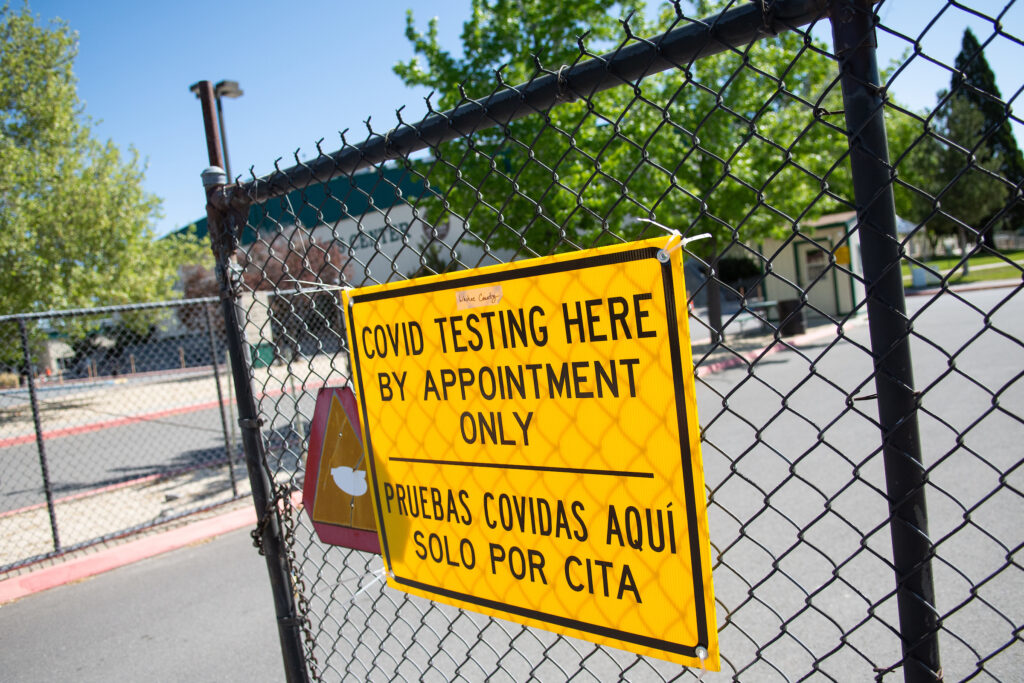
The Washoe County Health District’s drive-thru COVID-19 test site at the Reno-Sparks Livestock Events Center in Reno, Nev. on Friday, May 8, 2020. (David Calvert/The Nevada Independent) 
A COVID-19 billboard is seen from Interstate 80 in Reno on April 14, 2020. (David Calvert/The Nevada Independent)
But the system, imperfect as it was, represented a massive improvement from the state’s capabilities a year before. To date, 1 in 2 Nevadans has been tested for COVID-19 and 58,667 cases have been identified as a result of contact tracing efforts statewide, or about 20 percent of cases reported.
The state also launched a privately funded contact tracing app, called COVID Trace Nevada, in late August to help the contact tracing effort. Though the rollout of the app was initially slow, 687,244 Nevadans have downloaded the app or opted into exposure notifications on their smartphones to date and 265 Nevadans have entered a verification code into the app confirming their positive result which has resulted in 973 exposure notifications being sent.
Looking back, public health experts say perhaps the only way Nevada could’ve ramped up testing and contact tracing to the levels we eventually ended up needing in the fall would likely have been to have a cohesive national plan and federal financial investment back in February or March.
“At the time, there were few enough cases that it was actually practical to perform contact tracing around every case. But of course, that was also the period when the [Trump] administration felt that because there were so few cases we have very little to worry about,” said Dr. Kevin Murphy, an infectious disease specialist in Reno. “That was a golden missed opportunity.”
The hospitals, meanwhile, were not all right.
By fall, Nevadans and others across the U.S. had grown weary of mitigation measures and had started to engage in riskier behaviors. Increasing numbers of COVID-19 cases soon followed here and nationwide. By then, the doctors inside the hospitals responsible for treating COVID-19 patients were growing tired too.
“I think it went from a sense of, ‘Okay, let's get this done. We're on the frontlines. This is a pandemic. We're going to see the light at the end of this tunnel,’ to, six months after that, ‘This is fatiguing. I'm tired of it,’” Scherr, the emergency room physician, said. “We had tons of endorphins at the beginning, our adrenaline was up, ‘This is what we do,’ to, ‘Damn, I’ve got to see this every day, all day.’”
Things got so bad that Renown finally started putting patients in the alternate care site — a parking garage-turned-medical unit. At Sunrise, the hospital was squeezing in patients in its old emergency departments and surgical post-op spaces. Some hospitals had patients in hallways waiting for rooms to open up. At one point, Scherr’s emergency medicine group offered its services to cover the night shift at one smaller hospital where two ICU physicians were responsible for covering 60 to 70 patients, just so the doctors could get some sleep.
“Ten days after Thanksgiving, that was the longest, probably hardest hit time during COVID,” Scherr said. “Especially in Vegas, we were over 100 percent hospital capacity. Our ventilator capacity was not close to being threatened because of our new treatment strategies, but our ICU capacity was.”
As bad as things were, hospital association officials said Nevada never reached ICU collapse at any time over the last year. That’s the point where hospitals no longer have the equipment, supplies and people to provide the needed level of care to their patients. Though hospitals individually were stretched to 100 percent or more of their capacity, the system held.
But Lake, the hospital association’s executive director of community resilience, said Nevada “got pretty close,” particularly during the summer surge. At one point, ventilators loaned to the state from both California and the Strategic National Stockpile were being FedExed around the state to the hospitals that needed them.
“If you envision it as a rubber band that you’ve pulled so tight that if you add one more patient — the straw that broke the camel's back — that rubber band will snap,” Lake said.
It’s not exactly clear why the hospital situation in Nevada never was as severe this fall as it was in Southern California, which hit zero percent ICU capacity in December. There are, however, a number of theories.
One is that maybe Southern California hospitals are much more siloed and don’t lean on each other the way that Nevada hospitals do through their master mutual aid agreement. During each surge, Nevada hospital CEOs were on calls with each other every other day discussing capacity and who could take more patients.
Another is that maybe because Nevada experienced a significant surge in cases over the summer in a way that California didn’t, doctors had significant clinical competency by the fall. Doctors say that although this fall surge was stressful, there are now clearer protocols for treating COVID-19.
Maybe it’s just that Southern California is much more densely populated than Nevada so that when things got bad, they got really bad. Or maybe, for whatever reason, Southern California’s surge picked up speed faster than Nevada’s did and the mitigation measures that the governor put in place in late November successfully halted the spread.
Or it could be that it still helps to be a small state where everyone knows everyone. They have to, in some ways, to survive in a health care landscape that at times still feels like the Wild West.
“One of the upsides to being a small state and a state that doesn’t invest a lot of general fund [dollars] into public health is that we have to know our system and we know our partners,” said Richard Whitley, director of the Department of Health and Human Services. “One thing you have to do when you don’t have a lot of resources, you have to know what you do have and what you can rely on.”
The last year has been a rollercoaster.
As cases went up, down, up, down, up again, down again and now have plateaued, state officials tried to balance public health needs against economic needs. Businesses closed, businesses opened, there was a mask mandate, bars closed again, bars opened again, restrictions on large gatherings loosened, businesses and gatherings faced new restrictions and, now, finally, those restrictions are once again loosening.
Those ever-changing guidelines were part of an effort to respond to the current milieu and to ensure that the restrictions in place matched the current severity of the public health crisis. But oftentimes, they left residents confused and frustrated that things were changing once again.
As it turns out, the governor’s “Nevada United Roadmap to Recovery” plan from the spring would be just the first iteration of many documents outlining how the state would manage through the pandemic.
It would be followed by “Road to Recovery: Moving to a New Normal” in August, a plan that shifted much of the responsibility for implementing mitigation measures to a new statewide task force. Then, there was the “statewide pause” in November, which saw new limits be placed on businesses and gatherings. Now, we’re operating under “Nevada’s Roadmap to Recovery,” which plans to transition almost all responsibility for COVID-19 mitigation to local authorities.
It’s hard to say which mitigation measures have been the most effective.
Public health experts believe the case trends are probably, in part, psychological. Cases go up when people hear that cases are going down and feel safe to go out and do things; cases go down when people hear that cases are going up and they should be careful and limit their exposure. But they also believe the mitigation measures themselves have blunted the impact: When there are fewer people visiting a business or a smaller number of people at a gathering, there’s less of a chance that someone there has COVID and, if they do, hopefully more space to minimize transmission.
The one mitigation measure, though, that top public health officials say has been key to limiting case growth: the state’s mask mandate, which was announced on June 24 and went into effect two days later.
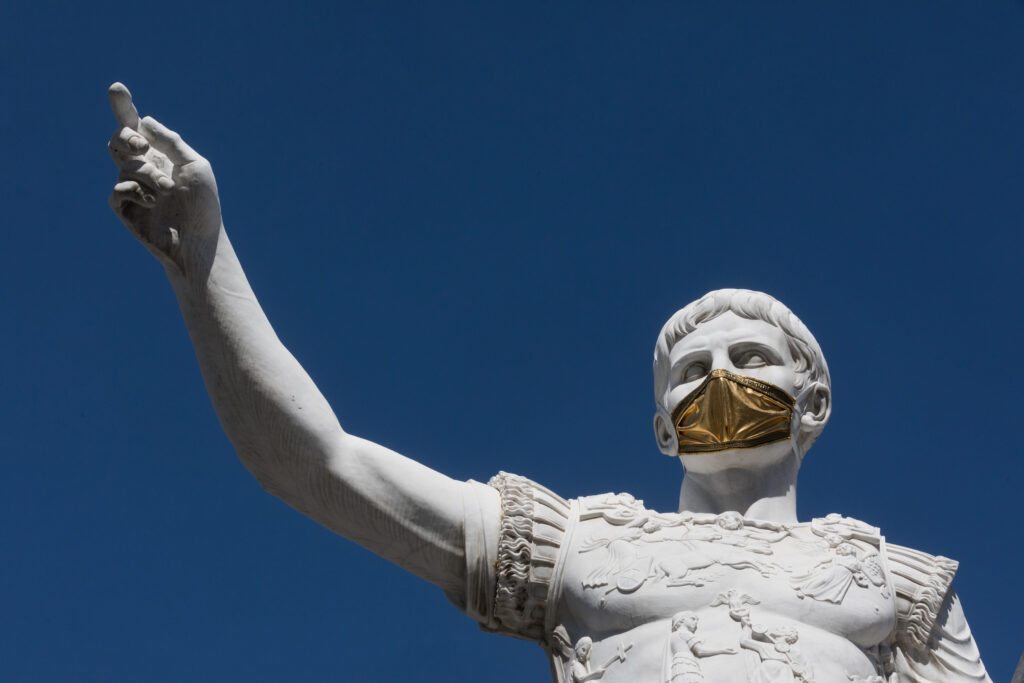
A statue is adorned with a gold face mask in front of Caesars Palace Las Vegas Hotel and Casino on Thursday, June 4, 2020. (Mikayla Whitmore/The Nevada Independent) 
A sign at Wingfield Park in Downtown Reno, Nev. along the Truckee River as seen on Saturday, May 9, 2020. (David Calvert/The Nevada Independent)
While Nevada was among the first 20 states to enact a mask mandate, multiple public health experts said they would’ve liked to see the state enact one sooner. At least seven states enacted mask mandates in April, six did in May and Nevada was one of five states to do so in June.
“[The Medical Advisory Team had] been discussing it for a while, trying to get support for that. It was just one of those things, it’s a political decision as much as it is scientific. We recognize those issues. But at the same time we were told, just think of the science. So from a scientific perspective, it's really easy to say, this is what you should do,” Labus said. “When you actually have to put it in place, it's a little different, and that's what the governor had to decide.”
The governor, for his part, said he didn’t even have a full understanding of how effective masks were when he put the mask mandate in place.
“It's easy to look back and say, yeah, I wish I’d have done it earlier, but I didn't know then what I know now,” Sisolak said. “I think at the time we made the decision as quick as I thought there was enough evidence to warrant that decision being made and that's why we did it when we did it.”
As other states like Texas and Mississippi have now begun to lift their mask mandates, Sisolak has made clear that Nevada won’t be heading in that direction. When the state transfers control of coronavirus health and safety measures to local governments in May, the statewide mask mandate will remain in place.
“I think that’s an irresponsible thing to do now,” Sisolak said of governors who are lifting mask mandates. “There’s no science or medical advice that says that’s the appropriate thing to do.”
The last year has been difficult, to say the least, for most. But Nevada’s public health workers, stoic as they may outwardly appear, are struggling.
They will acknowledge that they weren’t prepared and that there were areas where they might have done better. They’re sure that even more of that will become clear with time. But they also believe it wasn’t for lack of trying, and many of them are near their breaking points.
“It’s like we were pushing a wagon, and it worked when we had four people holding the wheels on and now you’re expecting us to enter NASCAR. Guess what? We’re not prepared, and it’s not for creativity or lack of effort,” Peek said, tearing up. “We're doing the best we can with the resources that we have.”
The deck was stacked against Nevada’s public health system from the start. Nevada ranks last in the nation for public health spending per capita. As recently as 2019, public health officials had pleaded with lawmakers for additional public health dollars, which they said would allow them to be more proactive in responding to Nevada’s health needs as they develop, instead of reactive, to no avail.
In some ways, it’s a miracle the situation hasn’t been worse in Nevada. But it has taken a toll on those trying desperately to hold the wheels on the wagon.
Hateful emails stacked up in their inboxes, health officials say. Peek-Bullock, the state’s epidemiologist, recalled someone suggesting picketing outside her house after she appeared at a press conference.
“That was the moment for me that it really hit home because that crosses the line between your work life and your personal life, and you think about your family,” she said.
Like every other Nevadan, the pandemic has taken a toll on their personal lives in other ways as well.
Cage, the state’s COVID-19 response director, has seen his brother and sister struggle to run their family-owned bars and restaurants in Reno. Both he and Sisolak have also been public about their experiences testing positive for the virus. Peek recalls trying to essentially homeschool her kids in real time while also working 12 hours a day. In the evenings, Kirkpatrick, the Clark County Commission chair, spends her evenings helping her 6-year-old granddaughter with her homework and getting her ready for bed before doing even more work. Dr. Tony Slonim, Renown’s CEO, learned he lost his dad to COVID the day the hospital held a press conference in April announcing the opening of their parking garage alternate care site.
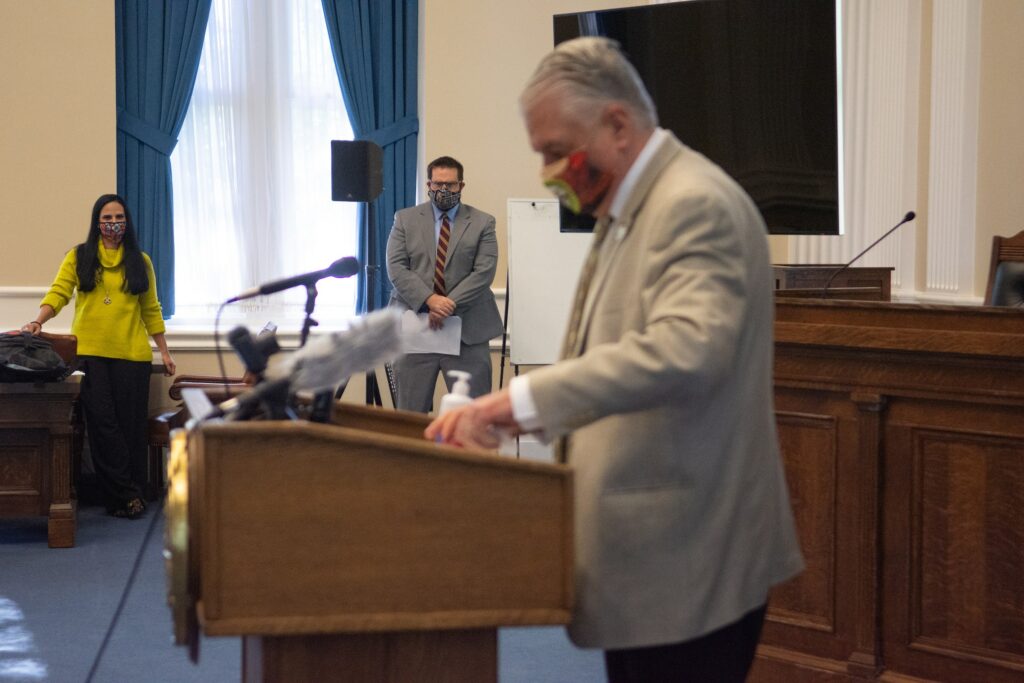
Division of Public and Behavioral Health Deputy Administrator Julia Peek, left, and COVID-19 Response Director Caleb Cage, during a press conference with Gov. Steve Sisolak on Monday, Aug. 3, 2020 in the former Assembly chambers in Carson City. (David Calvert/The Nevada Independent)
“You want nothing more than to do whatever you can to make their pain go away, right? In this case, it's the frustration, the uncertainty, the economic challenges, all of that, and trying to get to a place where you can do something that makes sense based on policy, based on science, and all of those things,” Cage said. “It doesn’t square with the emotional pull of doing something for a family member that you love dearly.”
They’ve felt overwhelmed and exhausted. They don’t know what to do with comments from people who suggest they have an agenda or are financially benefiting from the public health emergency. Many of them didn’t have their first day off from work until many months into the pandemic. As salaried employees, the state’s top health officials don’t get overtime and, in fact, have had their pay cut because of mandatory state worker furloughs. But, then, some of them have struggled with feelings of guilt because they feel lucky to have a job when so many others were and still are out of work.
They know they don’t always get it right. But they say their number one goal has been to wake up each day and do the best they can possibly do for the state of Nevada.
“The story is that the government is horrible and the government's doing something wrong, not that these people are working an ungodly number of hours per week and they rarely get to see their children for the good of Nevadans,” Peek said. “At some point we will have to exhale and we’ll have to shift down and go back to normal life. I don’t know how that’s going to look, honestly, we’ve been on full speed for forever. I don’t know how we’re going to go back to normal.”
The pandemic was always going to be an uphill battle, particularly for Nevada.
How is a state supposed to respond to a pandemic when it’s economy is built on the idea of bringing lots of people together from all around the world to a four mile patch of earth to have fun drinking and clubbing and gambling in close proximity to one another and then return home — exactly the things one ought not to be doing during a pandemic?
To the rest of the world, it may have appeared as if Nevada was being cavalier in its public health response when it made the decision to reopen casinos. But then, to the rest of the world, the totality of Nevada is Las Vegas and the totality of Las Vegas is the Strip, where we presumably all eat and drink all day long before going back to our high rise condos to go to sleep at night.
The rest of the world sees the waitresses, bartenders, bellmen and guest room attendants when they visit, the humans that make the casinos, and by extension, the state run, but they don’t see the homes those workers go back to and the families who rely on them to put food on the table. They don’t see the grocery store clerks, the delivery drivers and the teachers who make everyday life here possible. They don’t see how the taxes they loathe paying on their hotel rooms go to fund things like schools and Medicaid. They don’t see that — without the Strip, without the tourists, for better or for worse — life in Nevada ceases to exist.
State officials and public health experts knew on some level the casinos had to open. Perhaps only congressional approval of a universal basic income could’ve kept them closed. But the state’s decision to many felt — and still feels — contradictory, hypocritical even. Sisolak, during a press conference in mid-November, asked Nevadans to voluntarily stay home for two weeks as cases spiked statewide. But, when asked, he said the measure did not apply to tourists, who he urged to continue to travel to the state while following all health and safety protocols.
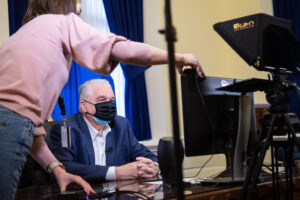
Sisolak, in an October speech, called it Nevada’s “great balancing act.”
“The public needs to understand that if we don’t step up together and follow all public health measures, hard decisions and trade offs lie ahead. This pandemic has been framed as a false choice, shut it all down or do nothing. But we know that's not the case. We know that doesn't have to be a reality. We know we can't afford it. We can continue doing our best to balance the health and safety of Nevadans with the need to protect our economy, keep people employed, provide an education to our kids, and more,” Sisolak said. “I promise that I'm doing everything I can to manage this balancing act, and that balancing act in Nevada is perhaps the toughest than any other state.”
But it was maybe less a balancing act than an attempt to make two inherently contradictory priorities live in harmony, like trying to force the negative ends of two magnets together. On one hand, there’s general agreement that bringing people together for lots of face to face interaction in casinos was probably not the best idea for stopping the spread of COVID. But if the casinos remained closed and tourists were warned against coming to the state, tens of thousands of Nevadans would be out of work, struggling to feed their families and keep a roof over their heads. They would be thrown into poverty, which brings its own set of negative public health consequences.
Nevada didn’t have the options some other states had. White, the governor’s chief of staff, recalled a conversation with an official from another Western state and wondering how leaders there had lessened the impact of the pandemic on their economy. The official told her that most of their employees were able to work from home.
“She goes, ‘Have you considered that?’ I’m like, ‘Well, we have, that would be phenomenal, but you can’t have the dealer or the valet or the cocktail waitress or the busser work remotely. We are a state that is funded primarily on face to face social interactions in large groups with a lot of people you don't know,” White said. “It's what makes us stay fun and great and amazing. In a pandemic, it puts policymakers and decision-makers in an almost impossible situation.”
In truth, maybe it wasn’t a balancing act between COVID and the economy but rather a balancing act between preventing people from dying of COVID now and preventing people from dying from poverty, mental health and substance abuse issues later.
From the perspective of those in the governor’s office, this was exactly what they thought they had been saying all along. But they realized the sentiment had, perhaps, only been peppered here and there in the governor’s speeches, in 20-page guidance documents and calls with the press. Perhaps it wasn’t clear enough to the public. That’s why they decided to have the governor drive the point home during an October press conference.
White said that the governor’s October speech was designed to speak to the frustrations of everyday Nevadans. The governor’s office understood that Nevadans were frustrated that their favorite family-owned restaurant was struggling while Strip properties were apparently bustling with tourists.
“As people view these decisions and form opinions on them, I don't blame them if they are sitting there saying, ‘This isn't fair, I'm mad.’ because they're looking at it through the lens of their world,” White said. “Putting myself in their seat, I might be mad too.”
Those close to the governor say that, as the pandemic progressed, he got more comfortable with living with, and governing through, the uncertainty. Sisolak has a reputation for being decisive — his critics would call him headstrong or a bully, even — and he’s someone who likes to make a decision and stick with it. They’re not qualities that naturally lend themselves to leading well during a pandemic.
“One of the things he had to come to grips with here — and it took a few months — is there wasn't a decision he was going to make that might still be the right decision in two weeks. He began to really live that moment and live with the need for flexibility and agility and constant adjustment — monitor, measure and adjust — knowing that when he did some of the reopenings that he might need to pull that back,” said Billy Vassiliadis, a longtime Democratic campaign consultant who is close to Sisolak. “It was more living in that moment and knowing that decisions needed to be done and revisited and done and revisited, I think he started to communicate that more confidently. He became more confident in the certainty of the uncertainty."
Sisolak, reflecting back on the last year, acknowledges that it was difficult for him as a leader to come to terms with the fact that there were no right answers and that he might choose to do something today he’d have to reverse tomorrow. And he knows that people have disagreed with him — there have been people carrying AR-15s outside the Governor’s Mansion in Carson City telling him so.
But he said that what he focused on was doing what he thought was right at the time and knowing that when he put his head on his pillow at night that he made his decisions with the right intentions.
“Can you have a disagreement on timing or on the severity of some decisions? Sure. People are always going to be there to disagree,” Sisolak said. “I'm telling you, when I looked at that Strip and those lights and saw them all going off, it's like, man, am I doing the right thing? Is this the right thing to do? And, yeah, I know it's going to be criticized. I know people aren’t going like it. I might have lost sleep over it, but I know I did the right thing.”
There are, of course, things that Nevada could have done differently.
We could have shut down earlier, harder and longer. We could have never shut down at all. Our schools could still be closed, or our schools could have opened fully months ago. We could have devoted even more time and resources to testing and contact tracing. We could have concentrated more power in the hands of the Legislature or local governments. We could have invested more in public health over the last decade. We could’ve invested in an aging unemployment system. We could have put much more effort into true economic diversification instead of, as always in good times, once again hanging our hat on the resort industry.
“When I look back at outbreaks, and I've been working outbreaks for two decades, at the end of the outbreak, it always plays out differently than you would expect it to at the beginning. The question I always have is, well, if I were in the same position, would I make those same decisions?” Labus said. “If I can say, yes, I’d make that same decision today, even knowing ultimately that it was wrong, but based on that information it was the right decision at the time, that’s how I look at our success.”
But even the death of one Nevadan to this virus was always going to be too many, let alone 5,000.
“You talk to a surviving family member of somebody that lost a family member to COVID and couldn't get into the hospital even to say goodbye to them, and it puts things in a different perspective,” Sisolak said. “That chair where that person sat at the kitchen table is always going to be empty.”
Part II coming Sunday, March 14.


